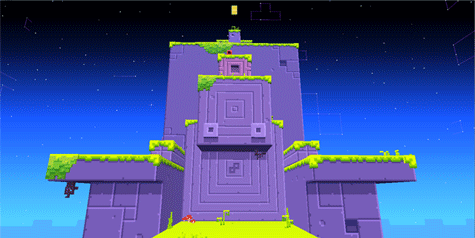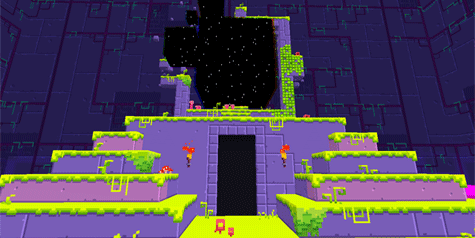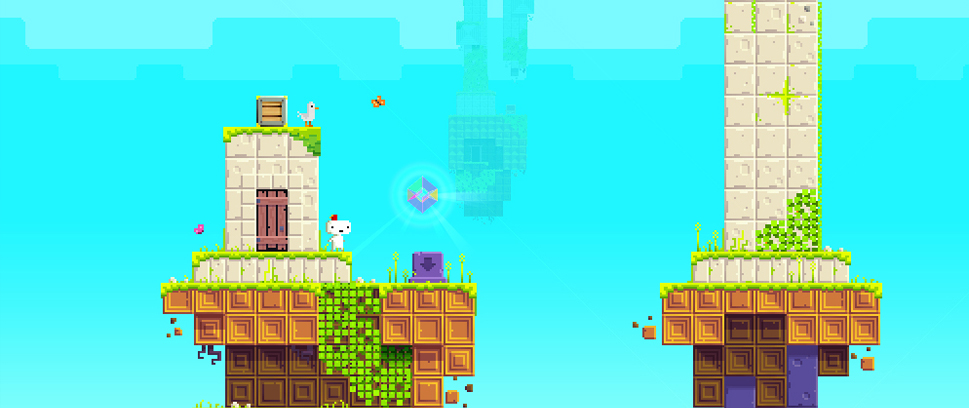Connected Perception and Concealed Dimensions
As enclosed, diegetic worlds that we navigate through, videogames allow us to explore spaces that can’t physically exist. Other media can explain or portray impossible spaces, but videogames allow you to actually experience them. You can read a dozen pages of description from Larry Niven’s novel Ringworld and try to comprehend how that world works. But in Halo you can just walk out of your crashed dropship, look up, and see a ringworld rise and wrap around above you, complete with the ring’s own shadow forming the terminator between night and day, and straight away you just get it.
 Yet, even if Halo’s ringworld is an impossible space, it still acts and reacts like any other normal place. Many other videogames, however, allow you to explore and comprehend impossible spaces through navigating them. Portal (and to a lesser extent, Prey) experimented with how space could be folded and reconnected in ways they never could be in reality, allowing for all kinds of new and impossible movements. Alexander Bruce’s forthcoming Antichamber goes a step further with spaces that simply don’t function the way we are used to space functioning – big rooms exist inside small boxes, and a forked path going upstairs and downstairs might take you to the same place. Even classic games like Pac-Man and Asteroids could be said to experiment with space, with the level-wrapping of going off one side of the screen and coming back on the other being a depiction of a kind of space that simply doesn’t exist in the real world.
Yet, even if Halo’s ringworld is an impossible space, it still acts and reacts like any other normal place. Many other videogames, however, allow you to explore and comprehend impossible spaces through navigating them. Portal (and to a lesser extent, Prey) experimented with how space could be folded and reconnected in ways they never could be in reality, allowing for all kinds of new and impossible movements. Alexander Bruce’s forthcoming Antichamber goes a step further with spaces that simply don’t function the way we are used to space functioning – big rooms exist inside small boxes, and a forked path going upstairs and downstairs might take you to the same place. Even classic games like Pac-Man and Asteroids could be said to experiment with space, with the level-wrapping of going off one side of the screen and coming back on the other being a depiction of a kind of space that simply doesn’t exist in the real world.
Impossible space is one thing, but unimaginable space is another. Is it possible to depict a space in a videogame that defies not only physics but also comprehension? Marc ten Bosch’s forthcoming game Miegakure seems to be attempting this with its four spatial dimensions. It’s a commendable goal, yet as fascinating as the game looks, it can’t help but be held back by the fact that humans can only comprehend three spatial dimensions at once. The 4D world will be there, and after a while maybe Miegakure’s players might start to think they understand it, but they’ll never fully see it, never in more than three dimensions at once.
Surprisingly, playing Polytron’s Fez is a similar feeling to what I imagine Miegakure is, but it takes a much simpler, polar opposite approach. Even though Fez’s world is a straightforward 3D world, it still gives me a taste of what it feels li ke to navigate a space beyond my comprehension.
ke to navigate a space beyond my comprehension.
Where Miegakure puts a 3D being into a 4D world, Fez places me in charge of a 2D character – Gomez – in a 3D world. Even after he receives the magical fez that allows him to rotate the camera and navigate through that mystical third dimension, Gomez remains a 2D character – he can still only ever move through two dimensions at once.
As a 3D being, I have no trouble comprehending three-dimensional space, but tied as I am in Fez to a 2D character, his restrictions become my restrictions, his comprehension becomes my comprehension, his experience of his world becomes my experience of his world.
When I press a shoulder button and the entire world spins on its horizontal axis, opening up some paths and closing off others, for a split second I see what the world is ‘really’ like. For about half a second and 89 degrees of rotation, I get a sense of depth, of that elusive third dimension.
But then the camera locks back in place and, once again, it is simply a 2D plane, the only kind of world Gomez knows how to relate to. Within moments the 3D world hinted at by the rotation is pushed to the back of my memory as I focus on moving Gomez through his 2D world.
It’s an empathetic coupling depending entirely on the existence of the character, Gomez. My own ability to navigate in three dimensions is constrained and afforded by what Gomez can perceive and what Gomez can do. Because my experience of Fez’s world is tied so closely to Gomez’s own experience, it is so easy to forget that its world even has a three-dimensional shape. The third dimension does not so much become concealed as it becomes temporarily nonexistent.
 It’s a double-edged sword. On one hand, it means I cannot simply walk around and navigate the world in three dimensions; on the other hand, because for Gomez there only ever exists two dimensions at any one time, the game’s trademark gameplay becomes possible: platforms that should be miles apart are instead right next to each other.
It’s a double-edged sword. On one hand, it means I cannot simply walk around and navigate the world in three dimensions; on the other hand, because for Gomez there only ever exists two dimensions at any one time, the game’s trademark gameplay becomes possible: platforms that should be miles apart are instead right next to each other.
Our experience of any videogame world is tied intimately to the body of the character through which we enter that world. In the case of Fez and Gomez, this has the effect of rendering a world that should be natural to me completely and utterly alien. It’s a basic and possible space, a simple three-dimensional world, but through the constraints and affordances of Gomez and my intimate connection with his existence, I got a taste of what it might be like to have to navigate though a world with more dimensions than I can perceive. Fez’s is a world that remains impossible to fully comprehend, one dimension fleeting into the shadows even as another reveals itself.



